The New York City Ballet presents its annual Fall Gala
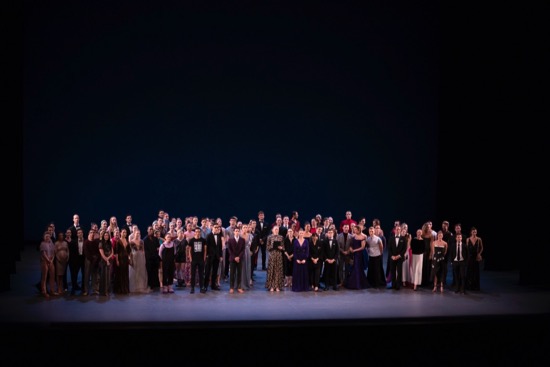
Members of the New York City Ballet gather while Teresa Reichlen addresses the audience at the company’s Fall Fashion Gala. Photo: Erin Baiano
The crowd attending the New York City Ballet’s Gala on September 27th was certainly elegantly dressed (sometime daringly so: two men eschewed tuxes and appeared in floral-print suits). During the pre-performance performance of sipping drinks and snagging hors d’oeuvres, you had to be alert to the possibility of stepping on filmy trains. These are the pitfalls happily endured by all who contribute to keep one of our city’s major ballet companies flourishing.
The NYCB is currently in flux. Peter Martins, the company’s Ballet Master in Chief since 1983, is out of the picture, pending an investigation into charges of physical and mental abuse on his part by a number of company members. Dancer Chase Finlay resigned after colluding with his friends and colleagues Amar Ramasar and Zachary Catazaro —both of whom were fired—to post online suggestive photographs of a female dancer (plus raunchy comments) without her permission. Martins had drafted two of the choreographers for the Gala, Matthew Neenan and Gianna Reisen, and the third, Kyle Abraham, was chosen by Jonathan Stafford and Justin Peck— members of the Interim Artistic Team running the company, along with Craig Hall and Rebecca Krohn. Stafford, Hall, and Krohn, former NYCB dancers, are now Ballet Masters, while Peck, the company’s resident choreographer, is still listed as soloist.
The Gala, titled “Choreography & Couture,” began with an unexpected prelude. The curtain rose on a stage full of dancers in offstage attire (by my count, nearly all the company members), listening intently while Teresa Reichlen read a statement that she had written with a fellow principal dancer, Adrian Danchig-Waring. She spoke clearly and bravely of a company whose members deserved equal respect, and of the need for relationships that valued “dignity, integrity, and honor.” (I admit to sudden tears. That they should have to ask for this!)
As in last year’s Gala, each of the choreographers was paired with a designer from the fashion world: Gareth Pugh (Neenan), Alberta Ferretti (Reisen), and Giles Deacon (Abraham). Marc Happel supervised the construction of all the costumes. A difficult job. Inevitably, the attire and the choreography occasionally struggled to work together onstage. (It was instructive to see, in an introductory film, a dancer in a long red gown politely pointing out that unless the skirt was slit, she wouldn’t be able to lift her leg.)
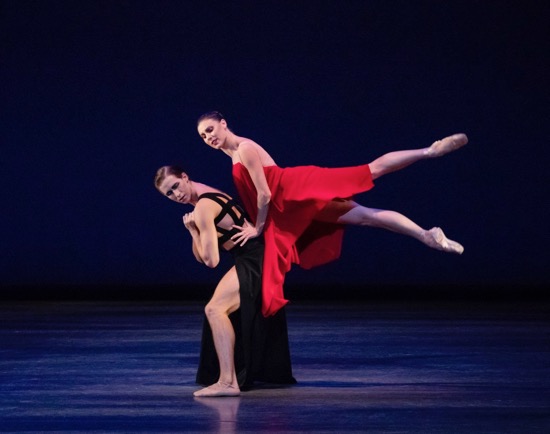
Joseph Gordon and Tiler Peck in Matthew Neenan’s The Exchange.
Photo: Paul Kolnik
Neenan has been making pieces for ballet companies since 2005—first for his own group, then for various others. He knows his craft: how to make a pas de deux seem like an intrigue between partners, how to combine attractive steps. His premiere, The Exchange, was set to the first movement of Antonín Dvorák’s first string quartet and two of the composer’s waltzes. The ballet’s ambiance suggests a misty fairytale, with hints of alliances and confrontations. Russell Janzen, Joseph Gordon, Anthony Huxley, and Sean Suozzi wear Pugh’s most compelling outfits: full, slit black pants with black bands crossing their bare chests. The short, billowy, red dresses worn by Maria Kowroski and Tiler Peck (Janzen’s and Gordon’s partners) conceal their bodies, while Emily Gerrity and Unity Phelan, also in red, are sleeker. And, during a sudden burst of playful dancing by Huxley and Suozzi, did I detect dark makeup around their eyes?
I fault my own fatigue as a contributor to my mystification, but who were these people? When the ensemble of four red-clad women and four men appear with red fabric veiling their faces, or when a veiled man supports and controls an unveiled one, what is at stake? What, as per the title, is being exchanged?
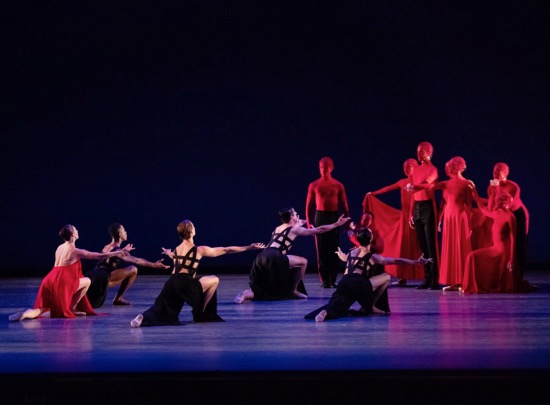
A confrontation in Matthew Neenan’s The Exchange. Photo: Paul Kolnik.
Dance can convey narrative elements without pinning them down. Sometimes we watchers accept that. Did anyone ever think about asking Balanchine why that man in his Serenade was traveling with a woman hanging onto him from behind and covering his eyes with her hand? I doubt it. But sometimes enigmas can be worrisome— that is, what am I not getting?
For her new ballet, Reisen too trafficked in enigma—shreds of it anyway, starting with the title: Judah, a reference to “Judah to Ocean,” one section of the music to which the dance is set: John Adams’s striking John’s Alleged Book of Dances— a mystery in itself. This is the second ballet that NYCB has commissioned from the gifted Reisen. A graduate of the company’s New York Choreographic Institute, she made her first ballet for NYCB, Composer’s Holiday, in 2017, when she was eighteen years old.
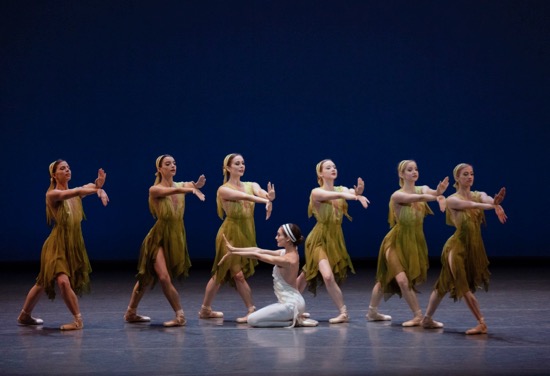
Giana Reisen’s Judah. Lauren Lovette, backed by (L to R): Mary Thomas MacKinnon, Eliza Blutt, Jacqueline Bologna, Alston Macgill, Emma Von Enck, and Baily Jones.
Photo: Paul Kolnik
A light percussive beat begins Judah by inciting the members of the string quartet in the orchestra pit to play Adams’s “Rag the Bone.” The curtain hasn’t opened yet when six women march purposefully across in front of it. They’re clad in Ferretti’s lightweight, greeny-gold dresses that make you think of tropical foliage, and they appear often in Judah as a dutiful chorus—always, as I recall, in unison.
Judah, lit, like The Exchange, by Mark Stanley, is admirable in its ambitiousness. It would be a mistake to emphasize Reisen’s youth when dealing with a work so fully developed. The six women mentioned above make up only one of its layers. Three women in blue are slid onto the stage by three matching men. Eventually we’re introduced to three vivacious women in red (Sara Adams, Megan LeCrone, and Indiana Woodward) and a male soloist in blue (Harrison Ball). When the guys in blue fall to the floor, one of the women jumps over them. The individuals and squads of dancers come and go, Reisen deploying them deftly, organizing them into patterns, but occasionally emphasizing their differences, as if the jaggedness of Adams’s astutely arranged short pieces has infected her, as well as its speed and drive.
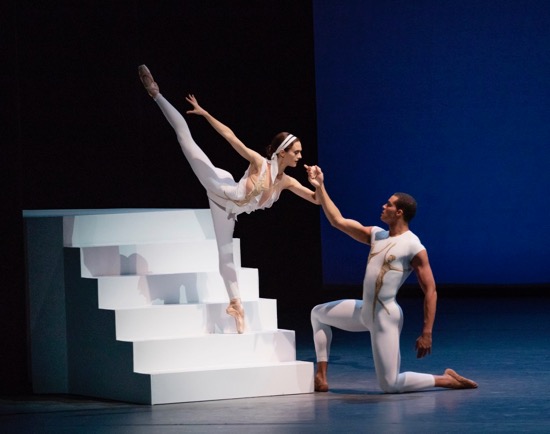
Lauren Lovette and Preston Chamblee in Gianna Reisen’s Judah.
Photo: Paul Kolnik
White staircases on either side of the stage become temporary roosting places, and they also facilitate the image of Judah’s top “layer:” Lauren Lovette and Preston Chamblee, both in white, each atop one of the structures gazing at each other across the space. They’ve entered earlier, Lovette attended by the women in gold, who practice the same curious wrists-touching gestures that she does.
Sudden symmetry leads to a blackout, and the audience starts to applaud, but Reisen wants to work her patterns a little more, and everyone is still dancing when the curtain descends.
The Runaway is Abraham’s first work for a major ballet company, although he has contributed choreography to other companies as well as directing his own group, A.I.M. (originally Abraham in Motion). He has been granted a MacArthur Fellowship and won several other prestigious awards. And he is the first African American choreographer to set a work on the New York City Ballet in many years.
He studied ballet a decade or so ago when pursuing his MFA from New York University’s Tisch School of the Arts (disclosure: I knew him back then), but he draws his movement vocabulary from modern dance, hip-hop, and whatever seems meaningful to him. Most of the music for The Runaway consists of compositions by Nico Muhly, played by violinist Nicolas Danielson and pianist Nancy McDill, but its score, edited by Abraham, introduces recorded items by Kanye West, Jay-Z, and James Blake (with additional artists). Audience members greet some of these musical “guests” with startled and appreciative recognition.
Abraham is generous enough to list his choreography in the program as being “in collaboration with NYCB.” And you can imagine the eight company dancers involved being happy to demonstrate their speed of foot to inspire him as he wove his choreography. One of the many things that impress me about Abraham is that despite the multiple movement sources he draws from, his work always looks seamless and particular to him.
Seamlessness is not a quality that characterizes Giles Deacon’s bold black-and-white costumes for the ballet. Threads draw skirts into puffs, make sleeves balloon. It’s as if someone once ripped apart some dressy Renaissance clothing, and someone else has reconstructed the remnants according to educated whim—a sleeve here, a headdress there. (It’s interesting that, initially, photos of the work were mistakenly captioned as “Runway.”)
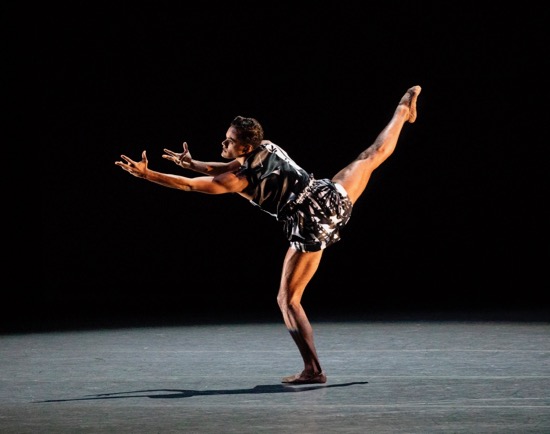
Taylor Stanley in Kyle Abraham’s The Runaway. Photo: Paul Kolnik
The Runaway begins with a remarkable solo by Taylor Stanley to Muhly’s Quiet Music. He’s standing crouched over in Dan Scully’s evocative lighting. His balletically expert legs begin to probe the air incisively, while his arms reach out, and his body ripples, wrenches, shudders. The effect is of a man struggling to dig into something—perhaps his memories. The ballet’s ending reinforces that impression: alone onstage, Stanley (magnificent in the role) works his way back to his opening stance, conveying the impression that all we have seen is a dream of his. Or a nightmare.
Watching the ballet, I begin to wonder what fragments of narrative bind the images of The Runaway together, and whether the runaway is Abraham avoiding elements of his usual style or a man letting his imagination run wild. “Febrile” is a word he used in an interview about this new piece.
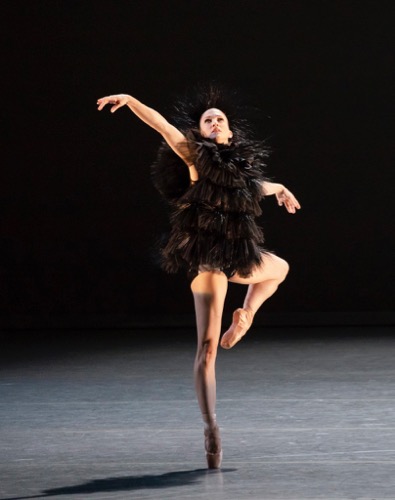
Ashley Bouder in Kyle Abraham’s The Runaway.
Photo: Paul Kolnik
Why does Ashley Bouder appear at one point (and on pointe) wearing what looks like the nest of a very large black bird and end her solo by tilting at the edge of the stage until she falls into the wings? Part of the time, Georgina Pazcoguin wears a floor-length slit skirt that announces her as having different priorities from the others. Sara Mearns and (at some point) Bouder top short black-and-white outfits with headpieces that sprout black “weeds” from either side of their heads. And, strangest of all, Peter Walker shows up for a somewhat contentious encounter with Jonathan Fahouri, his head completely concealed by an up-sprouting collar of those black fronds. As the two jump and prance, we hear Kanye West’s voice: “Today I thought about killing you/ Premeditated murder.”
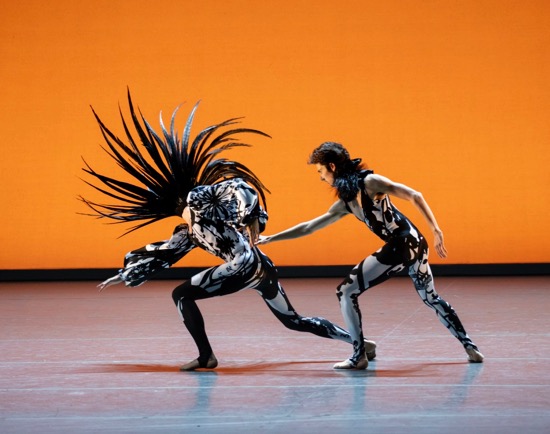
Peter Walker (L) and Jonathan Fahoury in Kyle Abraham’s The Runaway.
Photo: Paul Kolnik
Abraham makes use, in his own way, of ballet steps. The dancers, including Roman Mejia and Sebastian Villarini-Velez, are expert at such endeavors as whipping off a circle of piqué turns or beating their legs together in brisés. All eight are swift and elegant and somehow also cockeyed. Assembled and knocked apart. We think back on them and wonder as Stanley—who has at one point, danced in concert with the other four men—returns alone to his original spot onstage and slowly, slowly bends over, while the lights dim.
The audience gave The Runaway a standing ovation, before the patrons made their way up the aisles of the New State Theater to eat and drink and talk about what they had just seen. I hope they also took to heart that the choreographers weren’t all white men and perhaps even knew that Abraham had told an interviewer that he didn’t want to appear on a mixed bill that didn’t also present a work by a woman.
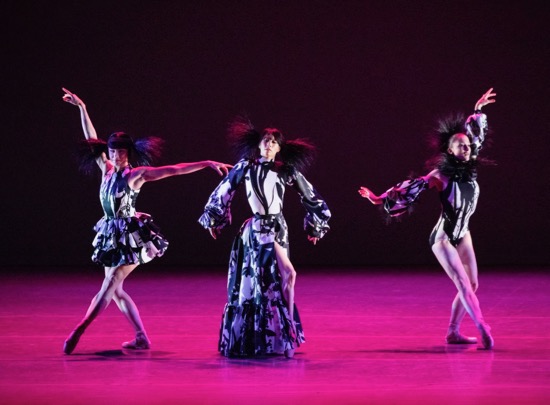
Kyle Abraham’s The Runaway. (L to R): Sara Mearns, Georgina Pazcoguin, and Ashley Bouder. Photo: Paul Kolnik
The New York City Ballet began its Fall Season with nine all-Balanchine performances, after which these three new acquisitions are inserted into various of the dozen variegated programs (some billed as “21st Century”) that offer ballets by Balanchine, Mauro Bigonzetti, Alexei Ratmansky, Christopher Wheeldon, Martins, and Peck. A “Short Stories” program leads into and follows three programs celebrating the centennial of Jerome Robbins birth. Finally, on Sunday afternoon, October 14th, Joaquin De Luz, the nimble, sparkling dancer born and raised in Madrid, performs for the last time with New York City Ballet, the company he joined fifteen years ago, after dancing for six years with American Ballet Theatre. His farewell performance acknowledges Balanchine (Theme and Variations and Concerto Barocco), Robbins (A Suite of Dances), and Martins (Todo Buenos Argentina).
The future of New York City Ballet, as it casts around for new leadership, is just another mystery. Meanwhile, it’s in extremely capable hands. Balanchine, Robbins, and Lincoln Kirstein, how could they not raise a virtual glass?
